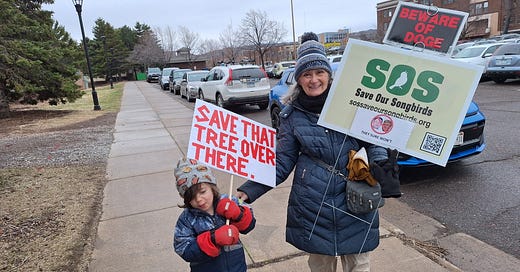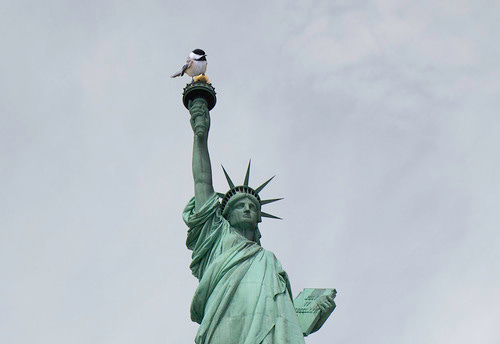(Listen to the radio version here.)
On the very first Earth Day in 1970, when I was an impressionable college student, I was filled with not just hope but absolute faith that the more Americans understood about nature and the interconnectedness of all living creatures, the more we’d commit ourselves to, first, slowing down how much we were hurting species and damaging our air and water, and eventually reversing course entirely, restoring as much as possible of the natural world of America to what it had been before Europeans arrived.
I was obviously naïve; there was no turning back. The American population was already orders of magnitude larger than when Europeans arrived. Estimates of the indigenous population of the Americas before European settlement range from about 50–100 million, with guesses about how many indigenous people lived in what is now the United States closer to 3 million; the U.S. Census set our population at 331 million in 2020; it tallied 203 million in 1970. The World Wildlife Fund reported that since 1970, the world’s population has risen by 123 percent even as wildlife decreased by 73 percent.
In 1970, many people already knew that the human population was too large to be sustainable over very many generations; Paul Ehrlich’s best-selling book, The Population Bomb, had been published in 1968. I’m mystified by how people can claim that his book was all wrong because we’ve found ways to feed and provide basic goods for the entire planet. Ehrlich’s numbers were based on the kind of agriculture and manufacturing we were then using; “advances” in both have destroyed vast amounts of forest and rainforest, savanna, grasslands, wetlands, and other sensitive habitats, contaminating them and our oceans, lakes, rivers, streams, and groundwater with heavy metals, plastics, fertilizers, and dangerous pesticides.
Yesterday, the American Lung Association released their 2025 “State of the Air” report, which found that nearly half of all Americans—156 million people, 25 million more than last year’s report—are breathing unhealthy levels of air pollution. The report noted that extreme heat and wildfires contributed to worse air quality for millions of people across the U.S. Had zero population growth become the norm in 1970, along with Nobel Prize-worthy economic strategies to make our economy sustainable without that constant “need” to keep growing the population, we’d be a far wealthier nation today in every way that matters.
In 1970, environmental optimism was richly rewarded. The political issues I cared about—the ones focused on protecting living beings and the world we share: civil rights, ending the war in Vietnam, and the environment—all made big strides forward during that decade. I think that’s why, ever since the 1970s, I’ve always felt a surge of optimism on Earth Day.
Unfortunately, that first Earth Day also marked the awakening of billionaires and their corporations to what would be required of all of us if we were serious about cleaning up and protecting the environment. The hoarding pathology of billionaires overrode any of the better angels that urge mentally healthy human beings to clean up our messes, help one another, and share.
Virtually all the environmental legislation enacted in the years immediately following Earth Day 1970 were passed by huge bipartisan majorities in both the House and the Senate. But the moment Reagan stepped into office in 1981 and promised to turn up the thermostat in winter—there’d be no more of Carter’s sweaters in his White House—and ripped out the solar panels Carter had installed on the White House, we who care about the environment were once again waging an uphill fight. And the billionaire forces keep growing stronger and more powerful. The Wall Street Journal just reported that in 2024—one single year—the 19 wealthiest American households gained more than a trillion dollars of additional wealth. Imagine that.
The hoarding pathology of billionaires overrode any of the better angels that urge mentally healthy human beings to clean up our messes, help one another, and share.
So this year, with our new Administration already destroying so many critical departments, agencies, and programs, this has become, more than ever, a government of the billionaires, by the billionaires, and for the billionaires. They grab everything they want without any of the responsibilities of taxation and regulation that the rest of us have long shouldered.
Walter came with me to Duluth’s Earth Day 2025 March. He’s too little to understand what is happening in the government right now, but he’ll be on this planet long after I shuffle off, and so I was thrilled that he wanted to join me. Some days lately, as I see dear friends lose their jobs, read horrifying news about innocent people sent to that Nazi-like concentration camp in El Salvador, and watch important advances in science, medicine, scientific research, and environmental protections tossed aside by an unelected billionaire co-president, I feel close to despair. But then I see my happy, kind-spirited, sweet little grandson, and I can’t help but smile, even as my resolve to protect this world for him grows ever firmer.







Two friends and I marched down the main street of Tower MN handing out flyers about Earth Day on Earth day in our plastic dresses (made from used plastic bags)! Two of us were 80 and one 90...wish some young people could have joined us...our Earth Circle group disintegrated during covid and has never came back ( in Grand Rapids MN)...your optimism keeps me hopeful!
bless your heart, laura, and thanks from my heart for all your work in this world.